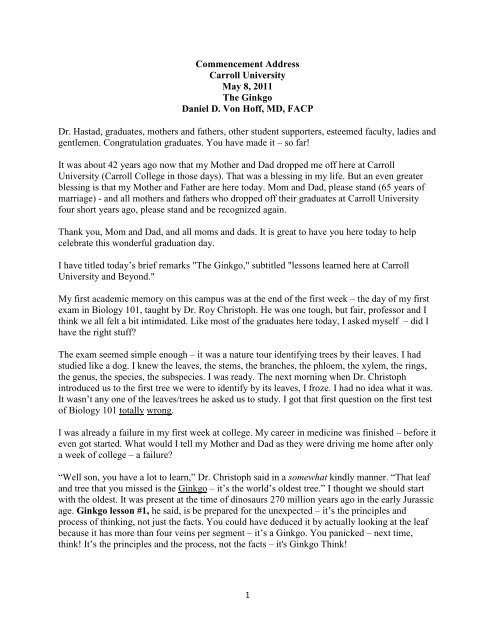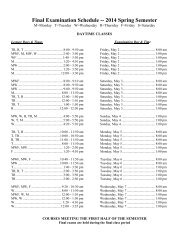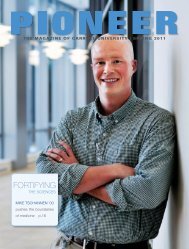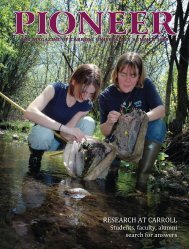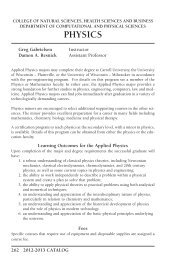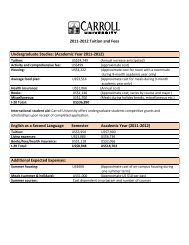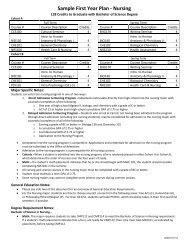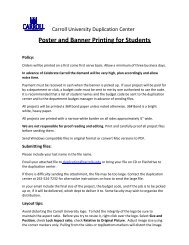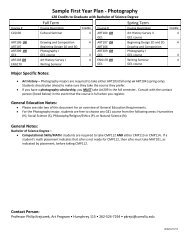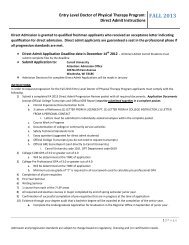Commencement Address Carroll University May 8, 2011 The Ginkgo ...
Commencement Address Carroll University May 8, 2011 The Ginkgo ...
Commencement Address Carroll University May 8, 2011 The Ginkgo ...
Create successful ePaper yourself
Turn your PDF publications into a flip-book with our unique Google optimized e-Paper software.
<strong>Commencement</strong> <strong>Address</strong><br />
<strong>Carroll</strong> <strong>University</strong><br />
<strong>May</strong> 8, <strong>2011</strong><br />
<strong>The</strong> <strong>Ginkgo</strong><br />
Daniel D. Von Hoff, MD, FACP<br />
Dr. Hastad, graduates, mothers and fathers, other student supporters, esteemed faculty, ladies and<br />
gentlemen. Congratulation graduates. You have made it – so far!<br />
It was about 42 years ago now that my Mother and Dad dropped me off here at <strong>Carroll</strong><br />
<strong>University</strong> (<strong>Carroll</strong> College in those days). That was a blessing in my life. But an even greater<br />
blessing is that my Mother and Father are here today. Mom and Dad, please stand (65 years of<br />
marriage) - and all mothers and fathers who dropped off their graduates at <strong>Carroll</strong> <strong>University</strong><br />
four short years ago, please stand and be recognized again.<br />
Thank you, Mom and Dad, and all moms and dads. It is great to have you here today to help<br />
celebrate this wonderful graduation day.<br />
I have titled today’s brief remarks "<strong>The</strong> <strong>Ginkgo</strong>," subtitled "lessons learned here at <strong>Carroll</strong><br />
<strong>University</strong> and Beyond."<br />
My first academic memory on this campus was at the end of the first week – the day of my first<br />
exam in Biology 101, taught by Dr. Roy Christoph. He was one tough, but fair, professor and I<br />
think we all felt a bit intimidated. Like most of the graduates here today, I asked myself – did I<br />
have the right stuff<br />
<strong>The</strong> exam seemed simple enough – it was a nature tour identifying trees by their leaves. I had<br />
studied like a dog. I knew the leaves, the stems, the branches, the phloem, the xylem, the rings,<br />
the genus, the species, the subspecies. I was ready. <strong>The</strong> next morning when Dr. Christoph<br />
introduced us to the first tree we were to identify by its leaves, I froze. I had no idea what it was.<br />
It wasn’t any one of the leaves/trees he asked us to study. I got that first question on the first test<br />
of Biology 101 totally wrong.<br />
I was already a failure in my first week at college. My career in medicine was finished – before it<br />
even got started. What would I tell my Mother and Dad as they were driving me home after only<br />
a week of college – a failure<br />
“Well son, you have a lot to learn,” Dr. Christoph said in a somewhat kindly manner. “That leaf<br />
and tree that you missed is the <strong>Ginkgo</strong> – it’s the world’s oldest tree.” I thought we should start<br />
with the oldest. It was present at the time of dinosaurs 270 million years ago in the early Jurassic<br />
age. <strong>Ginkgo</strong> lesson #1, he said, is be prepared for the unexpected – it’s the principles and<br />
process of thinking, not just the facts. You could have deduced it by actually looking at the leaf<br />
because it has more than four veins per segment – it’s a <strong>Ginkgo</strong>. You panicked – next time,<br />
think! It’s the principles and the process, not the facts – it's <strong>Ginkgo</strong> Think!<br />
1
I felt a failure that day, but I never forgot that leaf and tree and that it’s the principles and the<br />
process – it’s <strong>Ginkgo</strong> Think! That is why I have given each graduate a <strong>Ginkgo</strong> leaf in their<br />
programs today to symbolize that it’s the principles and process of thinking – <strong>Ginkgo</strong> Think –<br />
that is what will serve you well.<br />
<strong>The</strong> next four years here on this campus flew by – with teaching by many great professors like<br />
Dr. Ted Michaud, who I was so glad to see here today. I met many wonderful people and fellow<br />
students, including my dear wife of 38 years – Ann Shields Leighton – class of 1970. I worked<br />
like crazy and learned many great Gingko Think lessons.<br />
But like it is for you after today, it was now time for me to move on. Because of Drs. Christoph,<br />
Michaud, MacIntyre, Bayer and others encouraging me to stretch myself like the faculty has<br />
done for you, I got into medical school at Columbia <strong>University</strong> in New York City. Even more<br />
remarkable was that I was presented with a letter from an anonymous benefactor who said he<br />
would pay for the first three years of medical school on one condition – that someday, I would<br />
pay for all the medical school costs of a future medical student when I was able. Strangely<br />
enough, that letter was on stationery with a <strong>Ginkgo</strong> leaf imprint.<br />
<strong>Ginkgo</strong> lesson #2: If you had help to get here (and we all have), make it a habit to remember this<br />
special graduation day. Remember your struggles and when you are able, give monetary support<br />
to this university and to the students who follow you (and ask them to do the same). If we all did<br />
that, we really wouldn’t have to worry about keeping this special <strong>Carroll</strong> <strong>University</strong> here for the<br />
many next generations.<br />
<strong>The</strong> first years of medical school at Columbia were brutal. I worried the science and writing and<br />
teaching I learned on this campus might not be good enough compared to what my fellow<br />
students from Yale, Harvard, Swarthmore, Stanford and MIT had had. I was wrong again! –<br />
because I had been prepared to think. I had been prepared for the unexpected – I had <strong>Ginkgo</strong><br />
Think. I learned many important lessons at Columbia, working with pioneers of medicine, many<br />
Nobel laureates, first cardiac catheterization, discovery of a virus that causes cancer, discovery of<br />
four base pairs of DNA and many other incredible things.<br />
<strong>The</strong>re were so many special experiences, but one stands out as <strong>Ginkgo</strong> lesson #3: I was on a<br />
pediatric cancer assignment with a distinguished physician of the time, Dr. James Wolfe. We<br />
were asked to see a 3-year-old little girl with a big cancer growing out of her skull. It was the<br />
size of a baseball breaking through the skull. She was comatose, having jerking constant<br />
seizures. Her parents were in her room, quietly crying in despair. As we walked in, several<br />
nurses, a social worker and an ethicist asked us why were we there “That little girl doesn’t need<br />
you and she certainly doesn’t need any treatment. She needs to be left alone to die. It’s a<br />
hopeless situation.” “<strong>The</strong> parents have called us,” Dr. Wolfe replied. "We are here because the<br />
parents have asked us to be here." We pulled a curtain around the tiny helpless seizing child to<br />
examine her. Imprinted on that curtain was the <strong>Ginkgo</strong> leaf. As we talked with the parents, the<br />
parents were clear – do anything you can, anything to help our daughter, even if it helps for only<br />
a short period of time. Dr. Wolfe turned to me and said, “Well, Dan, what should we do Treat<br />
this child and be ready for the criticism which will surely follow, or do nothing” I looked up<br />
and saw that <strong>Ginkgo</strong> leaf on the curtain again. It seemed here that the principle was listen to the<br />
2
parents who loved this child. <strong>The</strong> answer was treat. Dr. Wolfe wrote the order for the new<br />
chemotherapy called daunorubicin. <strong>The</strong> hospital staff fought him every step of the way.<br />
Committees met, lawsuits were threatened, nurses refused to give it, so we gave it ourselves.<br />
That’s what the Mom and Dad who loved this child so much wanted us to do. Three days later,<br />
like a miracle, the tumor had dramatically decreased in size, the child was up running around,<br />
alert and loving. “Great idea to treat the child," all the nurses and the rest of the hospital staff<br />
said. “We certainly did the right thing, didn’t we"<br />
So, <strong>Ginkgo</strong> lesson #3: the ethics demand that you listen to what the individual person wants (be<br />
guided by them), not what others think they should have. Or, if the person can’t speak for<br />
himself, listen to the people who love that individual person. You will never get it wrong.<br />
Solomon saw who didn’t want the baby cut in half!<br />
Over the years, I have been privileged to care for many people, to give many new anticancer<br />
agents – some that didn’t work and some that did work. Recently, our science has improved so<br />
there are more and more effective therapies with fewer and fewer side effects. <strong>The</strong>re has been a<br />
decrease in the absolute number of cancer deaths in this country for the last four years. This is<br />
because of both early detection and improved treatment. At present, one in 20 Americans over<br />
the age of 20 are cancer survivors.<br />
Cancer is at least 200 different diseases and that is why it is such a tough adversary. But there are<br />
at least 30 of those 200 different types of cancer that can be totally cured. Overall, 68% of all<br />
patients (regardless of stage of cancer) can be cured – four times better than it was in 1971.<br />
Progress will continue to be made, but not fast enough for any of us. Graduates, I believe you<br />
will see all of the types of cancer cured in your lifetime.<br />
I have cared for many patients with all types of illnesses – helped many, and lost many. I have<br />
seen just about everything – pain, suffering, hope, hopelessness, caring, altruism, triumph. I have<br />
seen people in Haight-Ashbury with drug overdoses, jumpers off the Golden Gate Bridge – some<br />
who survived and many who didn’t – and even a mother of 18 who named her newborn number<br />
19 that I delivered after me – Daniella because that newborn was a girl – all of these experiences,<br />
starting from this small liberal arts school in the Midwest called <strong>Carroll</strong> <strong>University</strong>. Graduates,<br />
who knows what you will experience!<br />
Patients have taught me how to live; they have taught me how to die. And they have taught me<br />
the last Gingko lesson #4: which is that you must concentrate on each individual person you<br />
meet, identify with them and try to help them in every way possible.<br />
A recent patient, Mrs. L., a delightful 78-year-old woman, came to see us with the following<br />
request. “I have tried every treatment possible against my cancer. Can you biopsy it Run some<br />
tests on it to see if there is anything that will work for me now I know I am near the end. I just<br />
want to make sure I am not missing something that could help me.” Mrs. L. wanted the new<br />
approach – precision personalized medicine. We biopsied Mrs. L.’s tumor and profiled it in<br />
detail, but did not find a target for a therapy that would help against her cancer. I had to deliver<br />
that disheartening news. But I told her what we could do is offer her the best possible<br />
personalized pain and symptom control. And that helped her – a lot.<br />
3
Our patients and their families constantly teach us that digging deep and trying to help in any<br />
way we possibly can is so important. Here is the letter we recently received from Mrs. L.’s<br />
daughter on <strong>Ginkgo</strong> leaf imprinted stationery:<br />
To Everyone at TGen,<br />
Thank you so much for all that you did to try and help my mother. She felt so grateful to<br />
have known you all and so sad that her illness progressed so far that there was no new<br />
therapy that could help against her cancer. While she was with you, though, she felt so cared<br />
for and coddled – it was a wonderful experience. My mom passed away peacefully in my<br />
arms and spent her last few days surrounded by all her family in her own home. We all<br />
laughed, cried, prayed, reminisced and loved each other – it was a special time. Thank you<br />
again on behalf of my father and all our family.<br />
Gingko lesson #4: it's important to try. It is about curing, but it is also about caring – for the<br />
autistic child, for elders, for the suffering. An anonymous writer put it best – “to cure sometimes,<br />
to relieve often, to comfort always.”<br />
Graduates please remember:<br />
1. <strong>Ginkgo</strong> Think – it’s principles and the thinking process<br />
2. Give back<br />
3. Listen to what the individual wants<br />
4. Try to personally help each and every person<br />
I have gotten quite a few things wrong in my life – there have been a lot of <strong>Ginkgo</strong> lessons! But<br />
in the very beginning, I got one thing right. Like you, I went to <strong>Carroll</strong> <strong>University</strong>.<br />
And one more thing. A few days ago, my Mother and Dad gave me a birthday card for my 64 th<br />
birthday and, you guessed it! <strong>The</strong>re was a ginkgo leaf on the card. That card was sent with great<br />
love and many wonderful memories like we have here today. But based on what I have told you<br />
today, the message was clear. "Son, you still have got a lot to learn."<br />
Congratulations, graduates. You are now ready for anything unexpected. Remember Gingko<br />
Think!<br />
Thank you for the honor of giving this <strong>Commencement</strong> address,<br />
4


